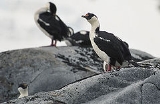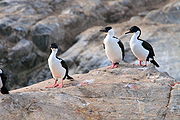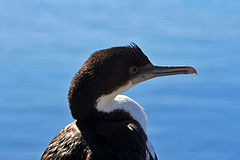
Imperial Shag
Encyclopedia
The Imperial Shag, Phalacrocorax atriceps, is a black and white cormorant
native to many subantarctic
island
s, the Antarctic Peninsula
and southern South America
, primarily in rocky coastal regions, but locally also at large inland lakes. It is sometimes placed in the genus
Leucocarbo instead. It is also known as the Blue-eyed Shag, Blue-eyed Cormorant and by many other names, and is one of a larger group of cormorants called blue-eyed shag
s. The taxonomy
is very complex, and several subspecies
are often considered separate species instead.
-limits within this group remain unresolved. The following are usually considered part of this group:
 While some authorities accept all of the above – except albiventer – as separate species, others consider all as subspecies of a single species (as done in this article). Alternatively, some recognize two species, the white-cheeked P. atriceps (with subspecies bransfieldensis, nivalis and georgianus) and the black-cheeked P. albiventer (with subspecies melanogenis and purpurascens), or it has been suggested that three species should be recognized: P. atriceps (incl. albiventer), P. georgianus (with subspecies bransfieldensis and nivalis), and P. melanogenis (with subspecies purpurascens and possibly verrucosus, though the latter is relatively distinctive, and most consider it a separate species, the Kerguelen Shag
While some authorities accept all of the above – except albiventer – as separate species, others consider all as subspecies of a single species (as done in this article). Alternatively, some recognize two species, the white-cheeked P. atriceps (with subspecies bransfieldensis, nivalis and georgianus) and the black-cheeked P. albiventer (with subspecies melanogenis and purpurascens), or it has been suggested that three species should be recognized: P. atriceps (incl. albiventer), P. georgianus (with subspecies bransfieldensis and nivalis), and P. melanogenis (with subspecies purpurascens and possibly verrucosus, though the latter is relatively distinctive, and most consider it a separate species, the Kerguelen Shag
).
 The Imperial Shag has a total length of 70–78 cm (28–31 in) and weighs 1.8-3.5 kg (4-8 lbs), with males averaging larger than females. It is endowed with glossy black feathers covering most of its body, with a white belly and neck. It possesses a distinctive ring of blue skin around its eyes, an orange-yellow nasal knob, pinkish legs and feet, and an erectile black crest. During the non-breeding season, adults lack the crest, have a duller facial area, and less/no white to the back/wings.
The Imperial Shag has a total length of 70–78 cm (28–31 in) and weighs 1.8-3.5 kg (4-8 lbs), with males averaging larger than females. It is endowed with glossy black feathers covering most of its body, with a white belly and neck. It possesses a distinctive ring of blue skin around its eyes, an orange-yellow nasal knob, pinkish legs and feet, and an erectile black crest. During the non-breeding season, adults lack the crest, have a duller facial area, and less/no white to the back/wings.
The subspecies vary primarily in the amount of white on the cheeks/ear-coverts, wing-coverts and back. Most taxa have white cheeks and ear-coverts, but these are black in albiventer, purpurascens and melanogenis. Chicks are uniform brownish, and immatures are brownish and white (instead of black and white), have dull facial skin, and lack the orange-yellow nasal knob and blue eye-ring.
 This is a colonial, monogamous species. The colonies are usually relatively small, but some consist of hundreds of pairs and are often shared with other seabirds such as Rock Shag
This is a colonial, monogamous species. The colonies are usually relatively small, but some consist of hundreds of pairs and are often shared with other seabirds such as Rock Shag
s, Southern Rockhopper Penguin
s and Black-browed Albatross
es. The up to 5 eggs (usually 2-3) are placed in a nest made of seaweed and grass, and cemented together with mud and excrements. The eggs usually hatch in about five weeks, and are brooded by both parents. Many chicks and eggs are lost to predators such as skua
s and sheathbill
s.
s, polychaetes, gastropods and octopuses. The South American populations primarily feed on fish, especially Argentine anchoita
, while P. (a) nivalis primarily feeds on fish and polychaetes. Mean diving dept for the South American populations is almost 25 m (82 ft), while mean for P. (a) nivalis is 5 m (16 ft) and maximum 60 m (197 ft). Most feeding takes place in inshore regions, but at least some populations (e.g. the South American populations) will travel some distance from the shore to fish.
by BirdLife International
and IUCN. Most subspecies are relatively common with estimates of 10.000+ pairs of each, the exceptions being P. (a.) nivalis with approximately 1.000 pairs and P. (a.) purpurascens with approximately 760 pairs (has perhaps declined slightly from this figure in recent years). If these are considered separate species, it is likely one – or both – would qualify for a threatened status, and they are considered Vulnerable
by DEWHA. Due to their small ranges and relatively small populations, they are highly susceptible to pollution and climate change
s, and chance events such as storms. Deaths due to strikes with radio masts have been recorded in both, and are quite common in P. (a.) purpurascens. Introduced predators
potentially also present a serious threat, though none are currently present on Heard Island and cats have been eradicated from Macquarie Island, leaving "only" rats
, which, however, have been observed at nests of P. (a.) purpurascens.
Cormorant
The bird family Phalacrocoracidae is represented by some 40 species of cormorants and shags. Several different classifications of the family have been proposed recently, and the number of genera is disputed.- Names :...
native to many subantarctic
Subantarctic
The Subantarctic is a region in the southern hemisphere, located immediately north of the Antarctic region. This translates roughly to a latitude of between 46° – 60° south of the Equator. The subantarctic region includes many islands in the southern parts of the Indian Ocean, Atlantic Ocean and...
island
Island
An island or isle is any piece of sub-continental land that is surrounded by water. Very small islands such as emergent land features on atolls can be called islets, cays or keys. An island in a river or lake may be called an eyot , or holm...
s, the Antarctic Peninsula
Antarctic Peninsula
The Antarctic Peninsula is the northernmost part of the mainland of Antarctica. It extends from a line between Cape Adams and a point on the mainland south of Eklund Islands....
and southern South America
South America
South America is a continent situated in the Western Hemisphere, mostly in the Southern Hemisphere, with a relatively small portion in the Northern Hemisphere. The continent is also considered a subcontinent of the Americas. It is bordered on the west by the Pacific Ocean and on the north and east...
, primarily in rocky coastal regions, but locally also at large inland lakes. It is sometimes placed in the genus
Genus
In biology, a genus is a low-level taxonomic rank used in the biological classification of living and fossil organisms, which is an example of definition by genus and differentia...
Leucocarbo instead. It is also known as the Blue-eyed Shag, Blue-eyed Cormorant and by many other names, and is one of a larger group of cormorants called blue-eyed shag
Blue-eyed shag
The blue-eyed shags are a group of closely related cormorant taxa. All have a blue, purple or red ring around the eye ; other shared features are white underparts and pink feet....
s. The taxonomy
Taxonomy
Taxonomy is the science of identifying and naming species, and arranging them into a classification. The field of taxonomy, sometimes referred to as "biological taxonomy", revolves around the description and use of taxonomic units, known as taxa...
is very complex, and several subspecies
Subspecies
Subspecies in biological classification, is either a taxonomic rank subordinate to species, ora taxonomic unit in that rank . A subspecies cannot be recognized in isolation: a species will either be recognized as having no subspecies at all or two or more, never just one...
are often considered separate species instead.
Taxonomy
The taxonomy is very complex and speciesSpecies
In biology, a species is one of the basic units of biological classification and a taxonomic rank. A species is often defined as a group of organisms capable of interbreeding and producing fertile offspring. While in many cases this definition is adequate, more precise or differing measures are...
-limits within this group remain unresolved. The following are usually considered part of this group:
- Imperial Shag, Phalacrocorax (atriceps) atriceps, from coastal southern ChileChileChile ,officially the Republic of Chile , is a country in South America occupying a long, narrow coastal strip between the Andes mountains to the east and the Pacific Ocean to the west. It borders Peru to the north, Bolivia to the northeast, Argentina to the east, and the Drake Passage in the far...
and ArgentinaArgentinaArgentina , officially the Argentine Republic , is the second largest country in South America by land area, after Brazil. It is constituted as a federation of 23 provinces and an autonomous city, Buenos Aires...
. - King Cormorant/White-bellied Shag, Phalacrocorax (atriceps) albiventer, from the Falkland IslandsFalkland IslandsThe Falkland Islands are an archipelago in the South Atlantic Ocean, located about from the coast of mainland South America. The archipelago consists of East Falkland, West Falkland and 776 lesser islands. The capital, Stanley, is on East Falkland...
, and locally in southern Argentina and Chile. - Antarctic Shag, Phalacrocorax (atriceps) bransfieldensis, from the Antarctic PeninsulaAntarctic PeninsulaThe Antarctic Peninsula is the northernmost part of the mainland of Antarctica. It extends from a line between Cape Adams and a point on the mainland south of Eklund Islands....
and the South Shetland IslandsSouth Shetland IslandsThe South Shetland Islands are a group of Antarctic islands, lying about north of the Antarctic Peninsula, with a total area of . By the Antarctic Treaty of 1959, the Islands' sovereignty is neither recognized nor disputed by the signatories and they are free for use by any signatory for...
. - South Georgia Shag, Phalacrocorax (atriceps) georgianus, from the South Georgia and the South Sandwich IslandsSouth Georgia and the South Sandwich IslandsSouth Georgia and the South Sandwich Islands is a British overseas territory and overseas territory of the European Union in the southern Atlantic Ocean. It is a remote and inhospitable collection of islands, consisting of South Georgia and a chain of smaller islands, known as the South Sandwich...
, and South Orkney IslandsSouth Orkney IslandsThe South Orkney Islands are a group of islands in the Southern Ocean, about north-east of the tip of the Antarctic Peninsula. They have a total area of about ....
. - Heard ShagHeard ShagThe Heard Island Shag , or Heard Island Cormorant, is a marine cormorant native to the Australian territory comprising the Heard and McDonald Islands in the Southern Ocean, about 4100 km south-west of Perth, Western Australia.-Taxonomy:The Heard Island Shag is one of the blue-eyed shags,...
, Phalacrocorax (atriceps) nivalis, from Heard Island. - Crozet Shag, Phalacrocorax (atriceps) melanogenis, from the CrozetCrozet IslandsThe Crozet Islands are a sub-antarctic archipelago of small islands in the southern Indian Ocean. They form one of the five administrative districts of the French Southern and Antarctic Lands.-Geography:...
and Prince Edward IslandsPrince Edward IslandsThe Prince Edward Islands are two small islands in the sub-antarctic Indian Ocean that are part of South Africa. The islands, named Marion Island and Prince Edward Island, are located at ....
. - Macquarie ShagMacquarie ShagThe Macquarie Shag , Macquarie Island Shag or Macquarie Island Cormorant, is a marine cormorant native to Macquarie Island in the Southern Ocean, about halfway between Australia and Antarctica....
, Phalacrocorax (atriceps) purpurascens, from Macquarie IslandMacquarie IslandMacquarie Island lies in the southwest corner of the Pacific Ocean, about half-way between New Zealand and Antarctica, at 54°30S, 158°57E. Politically, it has formed part of the Australian state of Tasmania since 1900 and became a Tasmanian State Reserve in 1978. In 1997 it became a world heritage...
.

Kerguelen Shag
The Kerguelen Shag is a species of cormorant endemic to the Kerguelen Islands. Many authorities consider it a subspecies of the Imperial Shag.-Range and habitat:...
).
Description

The subspecies vary primarily in the amount of white on the cheeks/ear-coverts, wing-coverts and back. Most taxa have white cheeks and ear-coverts, but these are black in albiventer, purpurascens and melanogenis. Chicks are uniform brownish, and immatures are brownish and white (instead of black and white), have dull facial skin, and lack the orange-yellow nasal knob and blue eye-ring.
Breeding

Rock Shag
The Rock Shag , also known as the Magellanic cormorant, is a marine cormorant found around the southernmost coasts of South America. Its breeding range is from around Valdivia, Chile, south to Cape Horn and Tierra del Fuego, and north to Punta Tombo in Argentina...
s, Southern Rockhopper Penguin
Southern Rockhopper Penguin
The Southern Rockhopper Penguin group , are two subspecies of rockhopper penguin, that together are sometimes considered distinct from the Northern Rockhopper Penguin...
s and Black-browed Albatross
Black-browed Albatross
The Black-browed Albatross or Black-browed Mollymawk, Thalassarche melanophrys, is a large seabird of the albatross family Diomedeidae, and it is the most widespread and common albatross.-Taxonomy:...
es. The up to 5 eggs (usually 2-3) are placed in a nest made of seaweed and grass, and cemented together with mud and excrements. The eggs usually hatch in about five weeks, and are brooded by both parents. Many chicks and eggs are lost to predators such as skua
Skua
The skuas are a group of seabirds with about seven species forming the family Stercorariidae and the genus Stercorarius. The three smaller skuas are called jaegers in North America....
s and sheathbill
Sheathbill
The sheathbills are a family of birds, Chionidae. Classified in the wader order Charadriiformes, the family contains one genus, Chionis, with only two species...
s.
Feeding
The diet of this species consists of small benthic fish, crustaceanCrustacean
Crustaceans form a very large group of arthropods, usually treated as a subphylum, which includes such familiar animals as crabs, lobsters, crayfish, shrimp, krill and barnacles. The 50,000 described species range in size from Stygotantulus stocki at , to the Japanese spider crab with a leg span...
s, polychaetes, gastropods and octopuses. The South American populations primarily feed on fish, especially Argentine anchoita
Argentine anchoita
The Argentine anchoita, Engraulis anchoita, is an anchovy of the genus Engraulis, found in and around waters of Argentina. The species, that at present may be considered almost unexploited , plays a key role in the pelagic ecosystem of the Argentine waters.By biomass, it is the largest fish...
, while P. (a) nivalis primarily feeds on fish and polychaetes. Mean diving dept for the South American populations is almost 25 m (82 ft), while mean for P. (a) nivalis is 5 m (16 ft) and maximum 60 m (197 ft). Most feeding takes place in inshore regions, but at least some populations (e.g. the South American populations) will travel some distance from the shore to fish.
Status
Overall this species is not considered threatened and consequently listed as Least ConcernLeast Concern
Least Concern is an IUCN category assigned to extant taxon or lower taxa which have been evaluated but do not qualify for any other category. As such they do not qualify as threatened, Near Threatened, or Conservation Dependent...
by BirdLife International
BirdLife International
BirdLife International is a global Partnership of conservation organisations that strives to conserve birds, their habitats and global biodiversity, working with people towards sustainability in the use of natural resources...
and IUCN. Most subspecies are relatively common with estimates of 10.000+ pairs of each, the exceptions being P. (a.) nivalis with approximately 1.000 pairs and P. (a.) purpurascens with approximately 760 pairs (has perhaps declined slightly from this figure in recent years). If these are considered separate species, it is likely one – or both – would qualify for a threatened status, and they are considered Vulnerable
Vulnerable species
On 30 January 2010, the IUCN Red List of Threatened Species identified 9694 Vulnerable species, subspecies and varieties, stocks and sub-populations.-References:...
by DEWHA. Due to their small ranges and relatively small populations, they are highly susceptible to pollution and climate change
Climate change
Climate change is a significant and lasting change in the statistical distribution of weather patterns over periods ranging from decades to millions of years. It may be a change in average weather conditions or the distribution of events around that average...
s, and chance events such as storms. Deaths due to strikes with radio masts have been recorded in both, and are quite common in P. (a.) purpurascens. Introduced predators
Introduced species
An introduced species — or neozoon, alien, exotic, non-indigenous, or non-native species, or simply an introduction, is a species living outside its indigenous or native distributional range, and has arrived in an ecosystem or plant community by human activity, either deliberate or accidental...
potentially also present a serious threat, though none are currently present on Heard Island and cats have been eradicated from Macquarie Island, leaving "only" rats
Black Rat
The black rat is a common long-tailed rodent of the genus Rattus in the subfamily Murinae . The species originated in tropical Asia and spread through the Near East in Roman times before reaching Europe by the 1st century and spreading with Europeans across the world.-Taxonomy:The black rat was...
, which, however, have been observed at nests of P. (a.) purpurascens.

